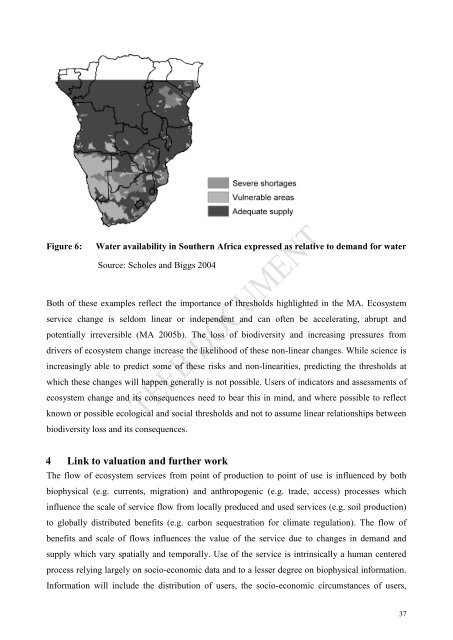Chapter 3 Measuring biophysical quantities and the use of ... - TEEB
Chapter 3 Measuring biophysical quantities and the use of ... - TEEB
Chapter 3 Measuring biophysical quantities and the use of ... - TEEB
Create successful ePaper yourself
Turn your PDF publications into a flip-book with our unique Google optimized e-Paper software.
Figure 6:Water availability in Sou<strong>the</strong>rn Africa expressed as relative to dem<strong>and</strong> for waterSource: Scholes <strong>and</strong> Biggs 2004Both <strong>of</strong> <strong>the</strong>se examples reflect <strong>the</strong> importance <strong>of</strong> thresholds highlighted in <strong>the</strong> MA. Ecosystemservice change is seldom linear or independent <strong>and</strong> can <strong>of</strong>ten be accelerating, abrupt <strong>and</strong>potentially irreversible (MA 2005b). The loss <strong>of</strong> biodiversity <strong>and</strong> increasing pressures fromdrivers <strong>of</strong> ecosystem change increase <strong>the</strong> likelihood <strong>of</strong> <strong>the</strong>se non-linear changes. While science isincreasingly able to predict some <strong>of</strong> <strong>the</strong>se risks <strong>and</strong> non-linearities, predicting <strong>the</strong> thresholds atwhich <strong>the</strong>se changes will happen generally is not possible. Users <strong>of</strong> indicators <strong>and</strong> assessments <strong>of</strong>ecosystem change <strong>and</strong> its consequences need to bear this in mind, <strong>and</strong> where possible to reflectknown or possible ecological <strong>and</strong> social thresholds <strong>and</strong> not to assume linear relationships betweenbiodiversity loss <strong>and</strong> its consequences.4 Link to valuation <strong>and</strong> fur<strong>the</strong>r workThe flow <strong>of</strong> ecosystem services from point <strong>of</strong> production to point <strong>of</strong> <strong>use</strong> is influenced by both<strong>biophysical</strong> (e.g. currents, migration) <strong>and</strong> anthropogenic (e.g. trade, access) processes whichinfluence <strong>the</strong> scale <strong>of</strong> service flow from locally produced <strong>and</strong> <strong>use</strong>d services (e.g. soil production)to globally distributed benefits (e.g. carbon sequestration for climate regulation). The flow <strong>of</strong>benefits <strong>and</strong> scale <strong>of</strong> flows influences <strong>the</strong> value <strong>of</strong> <strong>the</strong> service due to changes in dem<strong>and</strong> <strong>and</strong>supply which vary spatially <strong>and</strong> temporally. Use <strong>of</strong> <strong>the</strong> service is intrinsically a human centeredprocess relying largely on socio-economic data <strong>and</strong> to a lesser degree on <strong>biophysical</strong> information.Information will include <strong>the</strong> distribution <strong>of</strong> <strong>use</strong>rs, <strong>the</strong> socio-economic circumstances <strong>of</strong> <strong>use</strong>rs,37
















